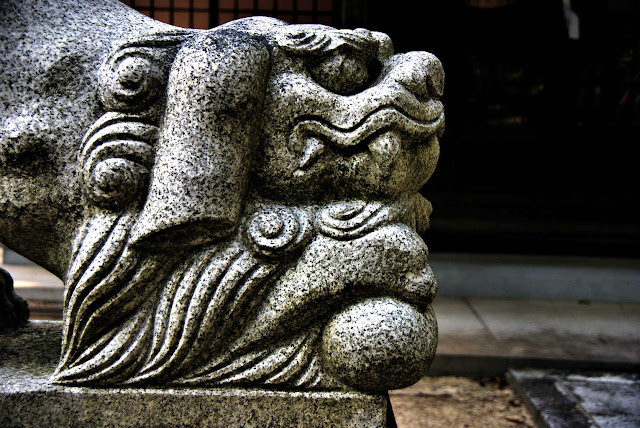EDIT...... I have since learned that this is a hachimangu shrine.
Wednesday, April 9, 2014
Hinobori Shrine
Saturday, April 5, 2014
Komainu of Shikoku part 2
The second post on the diverse styles of komainu I encountered in Shikoku while walking the pilgrimage. The first post is here. With bibs as paw warmers, at Temple 16, Kannonji.
Guarding the approach to Kushibuchi Hachman Shrine in Tokushima.
Wrapped in shimenawa at Ikuchi Shrine, Tokushima.
At Ebisu Shrine in Naka, Tokushima. the male will often be depicted with a paw resting on a ball, but here the ball is balanced on the paw.
Its female opposite, often depicted with a cub/pup. The upper jaw seems to be missing which gives it a strange appearance.
Thursday, April 3, 2014
Sanja Shrine
Sanja means " Three kami", and the three enshrined here are Izanagi, Hayatamano, and Kotosakano.
Labels:
aragami,
hayatamano,
izanagi,
izumo33,
kotosakano,
oyamakui,
Shrine
Tuesday, April 1, 2014
Yoshida Shoin History Museum
In the grounds of the Shoin Shrine in Hagi, Yamaguchi, is the Yoshida Shoin History Museum.
A series of lifesize tableaux depicts events from his life, including his attempt to leave Japan on Perrys' "Black Ship"
There is no information available in English, and unless you are a die-hard Shoin buff it is probably not worth visiting.
Labels:
hagi,
Museum,
yamaguchi,
yoshida shoin
Sunday, March 30, 2014
Izumo 33 Kannon Pilgrimage Temple 13 Manpukuji
It is now a Shingon temple.
Friday, March 28, 2014
Pilgrim No More
At 3:30 this afternoon I reached temple 108 of the Kyushu Pilgrimage, the Okuin of Temple 88 Chinkokuji, in Munakata. It has taken me 76 days to walk about 2,200 kilometers and I am bushed, but it has been a wonderful journey that has taken me to most corners of Kyushu. So for now I cease being a pilgrim..... until I start the Chugoku 33 hee hee.
The way home......
Tuesday, March 18, 2014
Sefa Utaki
Sefa Utaki is a World heritage Site on the southern coast of the main Okinawan Island. It was the most important sacred site for the royal family of the Ryukyus.
There are a series of shrines but no buildings are left. The path up the hillside passes through the verdant sub-tropical forest and by limestone cliffs.
At the highest point is Sanguii, a narrow cleft in the rock that leads to the most important altar. From here you can look down on Kudaka Island, the site where myth says the gods landed bringing grain and where the Okinawan people were created.
It's possible to get to Sefa Utaki by bus, though they are not frequent. It is worth it if only to get out into nature.
Labels:
okinawa,
world heritage
Saturday, March 15, 2014
Iishi Shrine
What is also unusual about Iishi Shrine is that there are no komainu or shimenawa, in fact no "decoration" at all.
Labels:
amenohohi,
engi shiki,
Izumo Fudoki,
izumo33,
kibitsuhiko,
kuniyuzuri,
Shrine,
takehiratori
Friday, March 14, 2014
Iwasaki Shrine, Usa.
In November of 2012 I went for a 5 day walk around and over the Kunisaki Peninsula, one of my favorite areas in Japan. I had been wanting to walk an old Shugendo pilgrimage route, but at that time had not yet found a reliable map of the route, however I did know that it started from Usa Jingu and headed east towards the peninsula and that is the route I followed.
Several hours into the walk I was approaching Usa Station and came upon Iwasaki Shrine. There was no information board at the shrine but I have been able to dig up a little info.
It was founded in 723 and the list of main kami is headed by Ojin and Jingu, and yet curiously its not called a hachimangu.
There are a lot of secondary shrines in the grounds, including Kibune, Konpira, Sugawara, Inari, and Izumo.
When I have finished all the posts on this walk I will post a chronological list, but for now all posts with kunisaki fall will suffice
Wednesday, March 12, 2014
Izumo 33 Kannon Pilgrimage, Temple 12, Jyufukuji
Subscribe to:
Posts (Atom)




































